Abstract
The fuel is not injected when the driver releases acceleration pedal of a vehicle with engine speed higher than about 1,500rpm in mid driving speed range. This is called ‘fuel-cut function’ and almost every modern vehicle is equipped with this function. This fuelcut function is activated on downhill parts of a highway most often. Therefore the vehicle-exhausted CO2 can be zero in these downhill parts if the driver could recognize these parts of highway. We compared the vehicle-exhausted CO2 emission with and without fuel-cut function in this study. The exhausted CO2 mass of a passenger car(2,000cc engine volume) is reduced by about 4% with this function in a test highway of South Korea. This CO2 reduction effect can be achieved if the downhill parts of a highway are painted with a specific color. And this road painting can be included in the highway road rehabilitation policy to cut down CO2 emission of vehicles.
Similar content being viewed by others
References
Ao, G. Q., Qiang, J. X., Zhong, H., Yang, L., and Zhuo, B. (2007). “Exploring the fuel economy potential of ISG hybrid electric vehicles through dynamic programming.” Transactions of IJAE, Vol. 8, No. 6, pp. 781–790.
Bielaczyc, P., Merkisz, J., and Pielecha, J. (2001). A method of reducing the exhaust emissions from DI diesel engines by the introduction of a fuel cut off system during cold start, SAE paper 2001-01-3283.
DEFRA (UK Department of Environment) (2010). Guidelines to DEFRA’s GHG conversion factors for company reporting, DEFRA, UK.
Hori, Y., Fukuda, M., and Kobayashi, Y. (1986). Computer simulation of vehicle fuel economy and performance, SAE paper No. 860364.
Kim, Y., Lee, H., Kang, J., Chung, J., and Chung, Y. (2009). “Effect of fuels on CO2 emission in CVS-75 mode.” Transactions of KSAE, Vol. 17, No. 4, pp. 72–78.
Ko, K., Jeong, S., Yoo, I., Lee, S., and Kim, J. (2010). “An experimental study on reduction of CO2 exhausted emission by using fuel-cut function of vehicles.” Transactions of KSAE, Vol. 18, No. 1, pp. 86–92.
Sa, J. S., Chung, N. H., and Sunwoo, M. H. (2003). “Experimental analysis of driving patterns and fuel economy for passenger cars in Seoul.” Transactions of IJAE, Vol. 4, No. 2, pp. 101–108.
Song, J. H., Kim, D. J., Lee, C. H., and Lee, C. B. (2009). “Simulation of effect of vehicle driving pattern of fuel consumption.” KSAE Annual Conference, pp. 2039–2044.
Author information
Authors and Affiliations
Corresponding author
Rights and permissions
About this article
Cite this article
Ko, K., Jeung, I., Yoo, I. et al. The highway road painting policy for reduction of Co2 with fuel-cut function in downhill part of highway. KSCE J Civ Eng 16, 351–356 (2012). https://doi.org/10.1007/s12205-012-1421-z
Received:
Revised:
Accepted:
Published:
Issue Date:
DOI: https://doi.org/10.1007/s12205-012-1421-z




